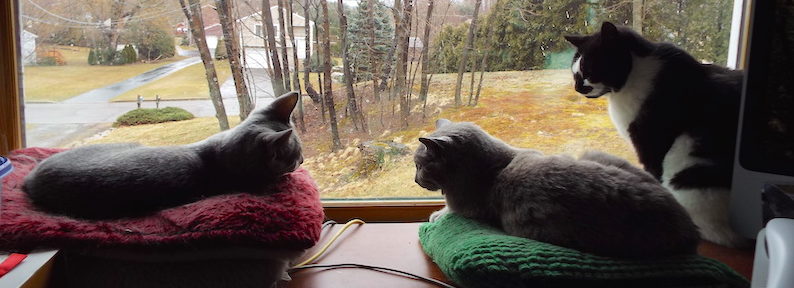There’s nothing like the joy of a living with a new kitten: the wide-eyed wonder, the playful antics, the unabashed energy. We love our older kitties, but every so often, there’s the siren call of kittenhood.
So how do you integrate a high-energy kitten into a household with a more sedate senior cat (or two)?
There’s no simple answer, but the process can be successful with some forethought and planning.
What to Consider
First, keep in mind the health and activity level of your older kitty. If she’s in declining health and has a limited activity level, you may think twice. The stress of kitten energy may be too taxing, especially if she requires special care and medication; an arthritic kitty who is slow in getting to the litter box may not appreciate being accosted by a curious kitten when doing her business.
If she’s been an “only” cat her entire life, she just may be set in her ways and the kitten may be seen as an intrusion.
One way to approach this is to pick a pair. Two bonded kittens can play and entertain each other and take the pressure off the senior citizen. Adopting an older kitty of the same sex is another consideration, keeping in mind that the two will likely keep to themselves.
Is your older cat used to having other cats around? Many multi-cat families have cats of varying ages, and their attitude can be: What’s one more? Still, take care to make gradual, supervised introductions.
If your older cat has lost a longtime companion, don’t assume she’ll want another. She may enjoy finally being the sole object of your affection. Give her some time and see how she reacts. You both need time to heal.
A cat who is experiencing grief may yowl, refuse to eat, or isolate herself. Give her some time and some extra attention, then think about adding a companion.
Bringing Kitten Home
The two older cats in my house are 10 and 16. They’ve always lived with other cats of varying ages, so they probably fall into the “what’s one more?” category. However, they are both rather set in their ways. Mollie, 10, can be a bit of a bully, while Tekla, 16, is laidback; she’s in good health, but not given to chasing toy mice.
Sofiya joined the household when she was almost 5 months old. She came from a litter of six and learned proper “catiquette”: that if you bit your sibling too hard, you’d get bitten back and it would hurt.
I kept her separated from Tekla and Mollie for the first couple of nights, but she was allowed to roam the house, supervised, during the day. If I hadn’t been home to keep an eye on things I would have kept her separated.
Depending on the personalities of the cats and the health of the newbie (for instance, a stray with an unknown history), you may want to set up a sanctuary room with comfy beds, food, and litter box. Do a scent exchange by rubbing one cat with a sock or t-shirt and leaving it for the other, and vice versa.
Move on to feeding the cats on either side of the door, with the door cracked or blocked with a baby gate. Then graduate to supervised visits and playtime until they’re comfortable with each other. The timing depends on how the cats react to each other. A curious, energetic kitten may demand to be released sooner than later!
Playtime Is Essential
A small kitten who hasn’t yet been schooled may be annoying to older cats. Give her plenty of playtime to burn off her energy, and give older kitties plenty of one-on-one time to stave off jealousy. This is when it may a good idea to adopt a pair.
When making introductions, remember that vertical space is as important as horizontal space. It expands the territory, allows escape routes for the older kitty, and serves as a gymnasium for the kitten.
Getting Along
Sofiya had the kitten smarts to know that a hiss meant “keep your distance.” She respected that warning and was able to hang out with Mollie and Tekla with minimal conflict.
Because she was well socialized and confident, Sofiya shrugged off Mollie’s initial warnings. In short time, they became more comfortable with each other and now engage in friendly games of chase. Sofiya also shares the kitchen counter with Tekla at mealtimes.
While we don’t find all three snuggled together on the bed, there is indeed shared space, typical kitty interactions, and harmony.
This article was reviewed/edited by board-certified veterinary behaviorist Dr. Kenneth Martin and/or veterinary technician specialist in behavior Debbie Martin, LVT.
Sally E. Bahner has more than 40 years experience as a writer and editor on topics ranging from construction to cats. She specializes in cat-related issues, specifically nutrition, holistic care, and multiple cat behaviors. Bahner is an award-winning member of the Cat Writers Association and the Connecticut Chapter of the Society of Professional Journalists. She resides in Branford, Connecticut, with her husband Paul, and cats, Tekla, Mollie, and Sofiya.








